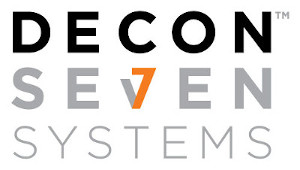
D7 Basic Mixing Instructions
D7 delivers a powerful and effective decontaminant, disinfectant, sanitizer, cleaner, and deodorizer for a multitude of application in various industries from military, first responders, to food and biosecurity. It’s unique properties make D7 easy to use while still providing the punch you need to eliminate the toughest microorganism challenges.
Below are the basic mixing and application instructions for the bulk D7 fluid. For BDAS+ instructions, click here.
To Mix:
- Pour equal parts of the Decon Seven Part I and Part 2 into a mixing container (plastic or glass), large enough to hold the components when completely mixed and stir the solution until it is well mixed (15-20 seconds).
- Add the Part 3 Booster (2.5oz per gallon of mixed Part1 & Part2) into the mixing container holding the Decon Seven Part I and Decon Seven Part 2 and stir the solution until it is well mixed (15 – 20 seconds).
- The mixture is now ready to apply as a foam, fog, mist, direct spray or mopped.*
Dilution for a standard home washing machine:
- Using a high efficiency front load washer 20 gal/h20 (1/4 Total cup (2oz) of D7 Part 1&2)
- Using a typical top load washer 40 gal/h20 (1/4 Total cup (2oz) of D7 Part 1&2)
Hudson type garden sprayer: Prepare solution and combine with water to achieve a 1:10 Ratio of finished product to apply.
Pressure washer application: Prepare solution and combine with water to achieve a 1:10 Ratio of finished product to apply.
Bath application: Prepare solution and combine with water to achieve a 1:10 Ratio of finished product to apply.
*Always Wear Proper Personal Protection Equipment
Application Instruction Guide
Decon7 DF200 Part I and Part II Anti-Microbial SolutionEqual parts of DF200 Part I and Part II are mixed at a 50/50 ratio (Volume/volume). Allow the mixture to stand for 5 minutes before using. Once mixed the solution will have a shelf life of 8 hours, after that time the solution must be discarded.
The pre-mixed solution can be misted,sprayed, foamed, mopped on or used as a bath. The application of the product will depend on the need and type of decontamination needed to be conducted. For best results it is important to remove as much gross filth or heavy soil prior to application of the product.
The product must be in contact with the affected area for at least 10 minutes. Keep in mind that DF200 will only decontaminate what it comes in contact with. Therefore it is important to thoroughly penetrate all contaminated areas and surfaces for maximum effect.
INDOOR FOGGING DISINFECTION PROCEDURE
- Remove any food that may be present, and any valuable personal belongings. Smoke and fire detection units should be disabled or covered.
- Technician should wear PPE (personal protection equipment) such as an organic cartridge respirator, eye protection, gloves and optional Tyvek suit.
- Mix Decon7 DF200 Part I and Part II equally into fogging machine. Typically 1 gallon mixed will cover from 4,000 square feet when atomized through a fogging machine.
- Enter Room and begin the fogging procedure, being sure to “fog / mist” into all areas including shower stall, exhaust fan, ventilation ducting. Under and around bed, furniture, closet.
- The “fog” will then have a “dwell time” of approximately 4-6 hours. This is the time in which Decon7 DF200 will be killing any virus, bacteria or spore present. Occupants should remain out of the rooms for this period of time.
- After the required “dwell time”, a wipe down clean-up for food preparation areas is recommended, using approved food prep surface cleaner.
- Room area will then be ready for occupancy and any post testing of surfaces.
OPTIONAL PROCEDURE
Decon7 DF200 can be mixed equally into a spray bottle and surfaces can be wetted, then the solution can be wiped onto that surface with a sponge or towel. This procedure requires latex gloves for skin protection, and general knowledge of “trouble” areas such as railings, doorknobs, hand holds, etc. Decon7 DF200 has extensive testing in virus decontamination, and has a “residual” barrier that will keep on killing long after the applications.